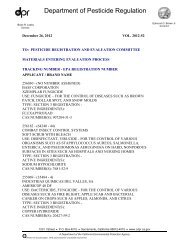Dichlorvos (DDVP) Risk Characterization Document - California ...
Dichlorvos (DDVP) Risk Characterization Document - California ...
Dichlorvos (DDVP) Risk Characterization Document - California ...
You also want an ePaper? Increase the reach of your titles
YUMPU automatically turns print PDFs into web optimized ePapers that Google loves.
adenocarcinoma in male rats (by gavage) was not statistically significant (the incidences were 0/44,<br />
0/50, 1/49, and 2/48 for 0, 0.2, 2, and 10 mg/kg-day) (Batham et al., 1984; Slagowski (1987). There<br />
was a dose-related decrease in mammary tumors in females. The highest dose tested (10 mg/kgday)<br />
was almost 2 fold-higher than that (5.7 mg/kg-day) in the <strong>DDVP</strong> rat oncogenicity study. Naled<br />
has not been shown to be genotoxic. Trichlorfon is not oncogenic in mice, dogs, or monkeys. The<br />
oncogenicity data for dietary exposure in rats were considered equivocal. The study was conducted<br />
in two parts (within two years). The first study was conducted with 0, 92, 273, and 1500 ppm. There<br />
was no evidence of oncogenicity (Hayes, 1989). The second study was conducted with only 0 and<br />
2500 ppm groups (Christenson, 1990). The 2500 ppm was determined to be the MTD based on body<br />
weight reduction and brain ChE inhibition (50%). The increase in the incidence of mononuclear cell<br />
leukemia (34%) was found only in females and was statistically significant (p @ 0.05). However, the<br />
concurrent control incidence (16%) was lower than that (26%) for the first study. Using a default<br />
consumption rate of 5% body weight (0.4 kg), the 2500 ppm dose is equivalent to 125 mg/kg-day.<br />
Trichlorfon has been shown to be positive in some genotoxicity assays.<br />
Occupational Exposure<br />
The MOSs for acute, chronic, and lifetime occupational exposures for all workers were less than 100<br />
(Table 23). The oncogenic risks for all workers were all higher than 1 x 10 -6 .<br />
Residential Exposure<br />
Residential exposures to <strong>DDVP</strong> were due to the use of liquid sprays, foggers, no-pest strips, and flea<br />
collars. Because the daily dosage was relatively low from flea collars, MOSs of 1100, 500, and 833<br />
for acute, chronic, and lifetime exposures, respectively, were determined for pet owners (Table 23).<br />
For other residents, the MOSs for acute, chronic, and lifetime exposures were less than 100, except<br />
for one group. The exception was structural residents after chronic and lifetime exposures where the<br />
MOSs were higher than 100. The oncogenic risks for all residents were higher than 1 x 10 -6 .<br />
Dietary Exposure<br />
The MOSs for acute and chronic dietary exposures were greater than 100 for all population<br />
subgroups, except for the MOS of 95 for the chronic exposure of children 1 to 6 years old (Table 24).<br />
For lifetime dietary exposure, the oncogenic risks (4 x 10 -5 to 7.7 x 10 -5 ) based on the average annual<br />
exposure level to all labeled uses were higher than 1 x 10 -6 .<br />
Using the USEPA dietary exposure estimates, the MOSs for the chronic exposure were greater than<br />
100 for all population subgroups. For lifetime dietary exposure, the oncogenic risks ranged from 7 x<br />
10 -6 to 1.3 x 10 -5 , and were also higher than 1 x 10 -6 .<br />
Combined Exposure<br />
The MOSs of 2 to 20 for the acute, chronic, and lifetime combined exposure from work and at home<br />
were less than 100 for all 3 types of workers (Table 25). The oncogenic risks for all workers were<br />
higher than 1 x 10 -6 .<br />
77
















